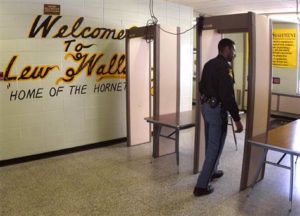
Update on: The War Comes Home: Violence and Death on America’s Streets
America’s wars have come home and goose-stepped right into the public schools where armed police patrol the hallways, stand guard at entrances, and operate metal detectors from kindergarten to high school. As in the larger society where civil liberties are threatened or in some cases abridged, the public schools are feeling the weight of an increasingly authoritarian state. [For its effects on civil society, read Part I “The War Comes Home: Violence and Death on America’s Streets”] America’s children are in the crosshairs of the militarization of domestic law enforcement combined with zero tolerance policies in schools. 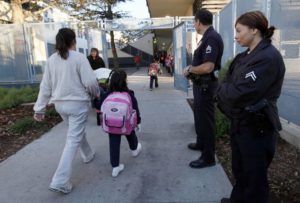 Even elementary school children are subject to suspension and, in a few cases, arrest. Armed cops in the schools, SWAT teams in the schoolyard are reminders that the rule of law has been replaced by state-sanctioned pre-emptive policing.
Even elementary school children are subject to suspension and, in a few cases, arrest. Armed cops in the schools, SWAT teams in the schoolyard are reminders that the rule of law has been replaced by state-sanctioned pre-emptive policing.
National data collected by the Center for Public Integrity — in the school year 2011-2012, six students out of every 1,000 were referred to law enforcement. What better indicator that “zero tolerance” policies criminalize ordinary teenage behavior? Back in the ‘good old days,’ student misbehavior was punished by detention or a trip to the 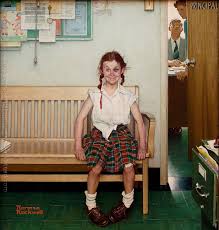 principal’s office —disciplinary measures that sufficed for 99.9% of students. Today we have police-enforced punishments for acts which rarely rise to the level of criminality. Where police are the arbiters of discipline, the ripple effect is felt by the entire student body. A student led away in handcuffs makes a mockery of the notion that schools are a “safe space” for children to learn and grow. Often left out of the argument for more police, more repressive discipline is the fact that public schools have an excellent safety record. From 2000-2010, 147 children were killed on K-12 campuses while 1,207 children 14-and-younger were killed in traffic accidents in a single year.
principal’s office —disciplinary measures that sufficed for 99.9% of students. Today we have police-enforced punishments for acts which rarely rise to the level of criminality. Where police are the arbiters of discipline, the ripple effect is felt by the entire student body. A student led away in handcuffs makes a mockery of the notion that schools are a “safe space” for children to learn and grow. Often left out of the argument for more police, more repressive discipline is the fact that public schools have an excellent safety record. From 2000-2010, 147 children were killed on K-12 campuses while 1,207 children 14-and-younger were killed in traffic accidents in a single year.
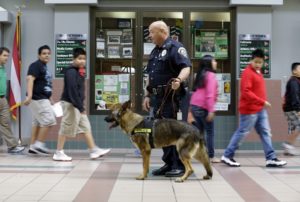 Over-policing and abdication by educators of their role in disciplinary matters create blowback often resulting in needless confrontations. A host of studies have found that in schools with an over-abundance of SROs (school resource officers, polite term for cops) referrals to law-enforcement agencies spike as do arrests. This is a generation of youngsters for whom school is a scary place with the specter of suspension, arrest, and incarceration hanging over their heads. An arrest or suspension is not a “one and done” but can have far-reaching effects on a youngster’s chances of getting into college, qualifying for a scholarship or being hired in a job requiring a background check. An arrest record is particularly problematic as the US transforms itself into a national security state and background checks are required for a vast array of public and private jobs.
Over-policing and abdication by educators of their role in disciplinary matters create blowback often resulting in needless confrontations. A host of studies have found that in schools with an over-abundance of SROs (school resource officers, polite term for cops) referrals to law-enforcement agencies spike as do arrests. This is a generation of youngsters for whom school is a scary place with the specter of suspension, arrest, and incarceration hanging over their heads. An arrest or suspension is not a “one and done” but can have far-reaching effects on a youngster’s chances of getting into college, qualifying for a scholarship or being hired in a job requiring a background check. An arrest record is particularly problematic as the US transforms itself into a national security state and background checks are required for a vast array of public and private jobs.
The U.S. national security state’s obsession with problems big and small in the area of student behavior verges on pathological — rewarding those who unquestioningly submit to the rules, criminalizing youngsters who have the temerity to ask WHY. The reputation of public schools as safe havens took a big hit in 2012 with the killing of 20 children and 6 adults in Newtown, CT. Suddenly the move was on to make schools military encampments. To arm school troops, the U.S. Defense Department (DOD), offered its surplus weapons and military uniforms to school police forces that wanted them. As of 2014, 22 districts in 8 states have taken the feds up on their offer and are the “proud owners” of among other war weapons M-14 and M-16 rifles, automatic pistols, SWAT gear, 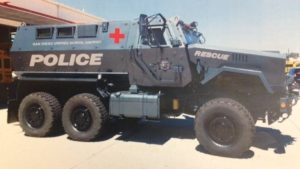 MRAP (mine-resistant ambush protected) vehicles, i.e. tanks, and grenade launchers useful for deploying tear gas and smoke bombs. Even the police are at a loss to explain how many situations in the school yard call for the services of a grenade launcher or armored tank. [NOTE: If you have school-age children or know people who do, look at the end of this article to see which states have been so gifted. If you are in one, move immediately]
MRAP (mine-resistant ambush protected) vehicles, i.e. tanks, and grenade launchers useful for deploying tear gas and smoke bombs. Even the police are at a loss to explain how many situations in the school yard call for the services of a grenade launcher or armored tank. [NOTE: If you have school-age children or know people who do, look at the end of this article to see which states have been so gifted. If you are in one, move immediately]
As with most military campaigns, keeping kids safe is far from the only rationale for garrisoning U.S. public schools. Race plays a huge role. In a DOE (Department of Education) report in 2014 (latest year for which figures are available) the disparity between serious punishments handed out to students of color vs. 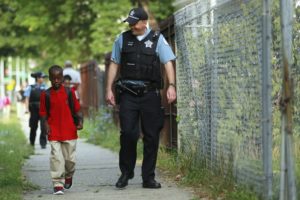 white students is mind-boggling. Black boys are three times more likely to be arrested at school than their white counterparts. African American girls are 1.5 times more likely than white boys to be arrested. Suspension and expulsion figures display the same disparity— Black students are suspended and expelled at a rate three times greater than white students.
white students is mind-boggling. Black boys are three times more likely to be arrested at school than their white counterparts. African American girls are 1.5 times more likely than white boys to be arrested. Suspension and expulsion figures display the same disparity— Black students are suspended and expelled at a rate three times greater than white students.
To make matter worse, news reports and data collected by advocacy groups show that in the last five years, 28 students have been seriously injured and in one case shot to death by police officers assigned to school detail on K-12 campuses. Although life-threatening use of force by police against school kids is rare, even one instance is too many. School counselors and education experts point to a lack of training and oversight that often lead to the use of force— particularly against minority and disabled students. A report put out in May, 2015 by the President’s Task Force on 21st Century Policing noted: “non-criminal offenses can escalate to criminal charges when officers are not trained in child and adolescent behavior.” Which makes a 2013 national survey that found only one state, Tennessee, whose police academies offer training for officers deployed to schools especially noteworthy. The report explained “the majority [of states] do not teach recruits how to recognize and respond to youth in mental health, trauma-related and specific education-related disorders.”
It’s time to try a technique on the local level that the Washington gang has removed from its bag of tricks. Talking instead of shooting. Negotiating instead of arming. Miracles happen when people talk to each other. All the stakeholders —law enforcement representatives, school administrators, teachers, parents, student council representatives, and local political leaders — can turn things around. Particularly if everyone agrees that public schools can once again become thriving enterprise zones where young minds get the tools they need to transform their world and ours.

Like the police shootings of unarmed black men, the overwhelming police presence in America’s public schools is a premonition that the havoc the military has wreaked around the world is coming home. If we do not act, “we shall surely be dragged down the long, dark, and shameful corridors…reserved for those who possess power without compassion, might without morality, and strength without sight. [“A Time to Break Silence,” April 4, 1967, Martin Luther King, Jr. While there are no videos of this speech, there are audio files (Listen here) and transcripts (read here).]
NOTE: The eight states that have opened the flood gates for DOD free weapons and gear to schools are: California, Florida, Georgia, Kansas, Michigan, Nevada, Texas, Vermont.

Follow Us on Twitter @SUSPIANGELS
Don’t forget to Like us on Facebook too https://www.facebook.com/suspiangels/
737 total views, 1 views today
